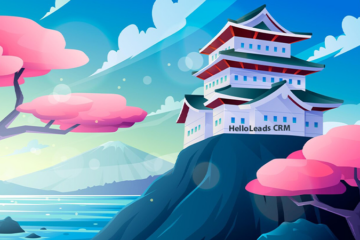
“ Lead generation yields high outcomes when combined with a competent lead management strategy.”
What is Lead Management?
The process of gathering, categorizing, and tracking the progress of activities on potential leads is known as lead management. Lead management is a customer relationship management module that deals with transforming an inquiry into a client. Visitors who express an interest in your product or service and are eager to purchase it are termed as leads. Phone calls, whatsapp messages, and website contact forms account for 80% of all business or commercial inquiries. The science of lead management is a systematic method of gathering those business inquiry leads and transforming them into customers.
10 essential components that may assist small firms in implementing time tested lead management practices.
Based on our extensive research and experience with managing clients over a decade, we have identified the ten most important aspects for a successful lead management process that can scale up a small business’s sales. The list is as follows:
- A well-crafted lead persona or lead information
- Clearly defined qualifiers
- Scoring of leads
- Distribution of leads
- Follow up and staying connected
- Templates for sending messages
- Lead nurturing
- Activity tracking
- Pipeline for the lead stage
- Leads or customers insights
The majority of our customers who have followed the above ten aspects have witnessed a 87% increase in sales. Let’s take a quick look at these ten essential aspects for improving lead management and sales.
1. A well-crafted lead persona or lead information

The foundation of a sound lead management process is to define an accurate lead persona or lead information. Lead information is divided into three categories: basic information, qualifiers, and supplementary information Contact information, qualifiers detailing their product/service of interest, and short remarks on their unique demand are examples of basic information. Additional information could include shared attributes like their social accounts, birth dates, etc. The systematic accumulation of this information will get your lead management process off to a solid start.
2. Clearly defined qualifiers
Qualifiers are intermediary factors that help you filter your leads before moving on to lead scoring and nurturing. In a lead management system, the qualification must include the Products/services that you provide including
- The market segments that your company targets.
- You may also provide certain regularly used tags, deal size or purchase value, and custom qualifiers if necessary.
3. Scoring of leads
The majority of CRMs, such as HelloLeads, features an automatic technique of rating leads based on the lead persona and qualifiers. The lead score may assist firms in better targeting and determining where to direct their sales efforts. The higher the lead score, the more you know about your lead, which can help you with faster conversions.
4. Distribution of leads

As a business owner, you may not be able to manage all of the leads on your own. You must distribute it to your staff to develop a business relationship with them, interact with them, and obtain their requirements before following up and converting them to clients. A well-managed lead management system is dependent on how leads are distributed and tracked. Lead distribution can follow any pattern depending on your company’s sales workflow. You may either assign a lead to a team member based on products, customer segment, or the lead’s owner (person who captures the lead). Many CRMs on the market include automated lead assignments based on their owner.
5. Follow up and staying connected
Follow-up is the most effective workout for keeping your sales and support teams in shape. Make it a habit for you and your team to have a well-planned schedule with sales and support follow-ups. Since human beings cannot recall more than 100 things at once, make it a habit to take down notes before scheduling the follow-up as well as after completion.
6. Templates for sending messages
Messaging is a necessary piece of the lead management process. You may use email, WhatsApp, or text messaging, but make it a practice to send communications to your leads and clients at regular intervals. As part of your lead management strategy, have a set of pre-written messaging templates ready. It is preferable to use a cloud-based lead management CRM application that allows you to save email/WhatsApp/text message templates. Here are a few examples of message templates:
- Product/ service introduction
- Meeting request
- Thank you note
- New product launch
7. Lead nurturing

81 percent of leads that are converted to customers go through a nurturing process. A deeper knowledge of the lead persona, on-time follow-up, and the relevant interactions (call/message) in an appropriate way may drive the prospect through the pipeline and convert him to a customer. Every startup or small business that takes note of the first six points mentioned above, are more likely to see a significant improvement in lead nurturing, sales, and repeat customers.
8. Activity tracking
Activity tracking refers to the chain of records that you may keep anytime you communicate with your lead or alter the stage of the lead from top to bottom (Open-> Contacted-> Qualified-> Customer). Every action, such as phone calls, emails or WhatsApp messages sent, comments, documents attached, and so on, is included in the record thread. This will greatly assist you and your team in doing an audit on each conversion or drop in sales.
9. Lead stage pipeline
The lead stage is the global standard for measuring the journey of leads from inquiry to becoming a client. Successful small businesses throughout the world use eight lead stages. A good lead management approach is to maintain these lead stages appropriately updated. An effective lead stage bucketing will keep you informed of the progress of the sale and allow you to take suitable steps. The eight recommended lead stages are :
- Open–inquiry
- Contacted – contacted and understood his requirement
- Nurturing – educating the lead
- Qualified – the lead is ready for purchase
- Negotiation – discussion on offers/ discounts and adjustments
- Customer – has purchased your product/ service, Leads Won
- Inactive – Was a customer some time back but dormant or inactive now
- Unqualified -the needs of the prospect do not match with your product or service.
10. Leads or customers insights
In lead management, insights are a statistical representation of metrics coming from action items 1 through 9 listed above. Standard lead management insights include the overall number of leads created, qualified leads based on the product of interest or segments, and the lead stage pipeline. These insights will assist you in refining your lead generating and selling approach. Spend some time evaluating the insights on a daily, weekly, monthly, and quarterly basis to increase your lead generation and overall sales.
Conclusion :
Lead management is crucial to growing a small business’s revenue. Increase conversion rates by using a lead management system to simplify the 10 important components of the lead management process.
Share this blog :










